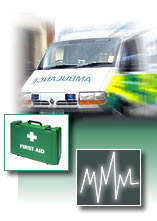| FIRST
AID IN AN EMERGENCY
First Aid is the temporary and prompt care given to
a person until professional help arrives. Before going to the aid
of a casualty, check that the area is safe for you and them, there
could be danger from electricity, chemicals, fast-moving traffic etc.
If a medical emergency occurs and the person is still conscious, ask
them what is wrong and where it hurts. If the person is not moving
ascertain whether they are conscious by tapping them and asking if
they are OK.
If the person is unconscious: Check the ABC's
- Airways
- Breathing
- Circulation
Immediately call 999 for emergency medical services
Do not give an unconscious person anything through the mouth. Do
not move the injured person unless the situation is life threatening.
You may cause further internal damage by moving them, especially
in
the case of neck and spinal injuries.
Due to the risks of infectious diseases, precautions are always
advised when dealing with any victim. Try and use latex gloves and
a mask
if possible. Always wash hands and other exposed areas of skin thoroughly
after giving First Aid.
For this guide an infant is less than a year old, a child is 1-8
years old, and an adult is over 8 years old.
Airway
Make sure the unconscious person’s airway is open. There are
two ways of opening a person's airway. The first is the modified
jaw-thrust and the second is the head-tilt/chin lift.
Modified jaw-thrust
procedure
ONE
Kneel behind the person so you are facing the top of the person's
head.
TWO
Hold the jawbone on both sides at the point where it angles
up towards the ears.
THREE
Move the jaw forward
and then upwards.
FOUR
Pull the lower lip back with your thumb if the
lips are closed.
Head-tilt/chin lift procedure
ONE
Kneel beside the person's shoulders.
TWO
Place the palm of one hand on
the person's forehead.
TWO
Place two fingers of your other hand
under the bony part of the chin.
THREE
To open the airway, lift the
chin in and then upwards whilst gently tilting the head backwards.
Breathing
After completing the head-tilt/chin lift or the jaw-thrust
procedures, place your head down, close to the
person’s mouth and listen
and feel for breathing whilst ensuring an open
airway. See whether the person's chest is rising/falling,
listen carefully for breathing and feel for any air escaping
from the person's mouth.
This process should only take a few seconds. If the
person is not breathing, keep the airway open and pinch the nose shut,
make a tight seal over the
person's mouth with yours and give two slow breaths (over two
seconds). In the case of
an infant or small child, cover the nose and mouth with your own mouth
and give two small breaths (between 1 - 1.5 seconds)
Circulation
Check that the persons blood is circulating by looking for signs of improved
colouring and eye movement. You can also check the persons pulse by placing
your index and middle fingers on the inside of the persons wrist.
|


